Pearls are popular elements to design different styles of jewelry. Except for perfectly round pearls, baroque pearls are also often used to manufacture jewelry. They are a combination of tradition and modernity, extremely versatile. However, you may only think of asymmetry when explaining what baroque pearl is. Actually, there are more characteristics of a baroque pearl.
Let’s dive deep into these pearls and explore their types, shapes, prices, and other attributes.
1. How Is A Baroque Pearl Made?
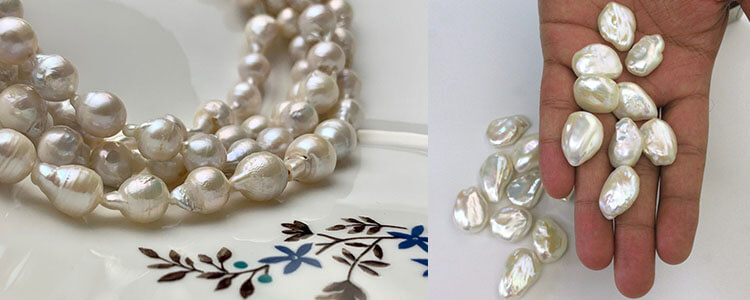
Baroque is a word of French origin meaning ‘Having irregular shape.’ Baroque Pearl is an eclectic term that covers any pearl having a non-spherical shape. The shape could vary from an elliptical to one having indentations. This asymmetry makes Baroque Pearls exclusive, as there are no two similar pearls in the world.
Baroque Pearls are formed in saltwater oysters and freshwater mollusks due to the deposition of the nacre. The time of deposition and uneven distribution of the nacre leads to an altered shape. In comparison, the color of the pearl is due to its host mollusk and the surrounding environment.
With grooves and dips on their surface, Baroque pearls reflect light differently and hence glow differently in different angles. Such a gleaming appearance makes these pearls even more striking.
2. Four Main Types of Baroque Pearl
Baroque Pearls have different types depending on their site of origin. The site of origin can either be freshwater or saltwater.
Freshwater Baroque Pearls

The freshwater mollusks are tissue nucleated, meaning no-bead inside them for a symmetrical deposition of nacre. Hence, asymmetrical deposition of nacre occurs, resulting in diverse bumps and ridges and eventually a true baroque pearl.
Most pearls growing in freshwater take their natural forms inside the organism and, therefore, are the finest baroque.
Baroque Keshi pearls are one of the freshwater pearls that are purely nacre. Within the pre-existing pearl, the deposition of pure nacre occurs that causes the birth of Keshi baroque pearls. The multiplied overlaying of minerals accounts for patterned yet unique baroque pearls.
Saltwater Baroque Pearls
Saltwater pearls are more complex. Most of them are beaded nucleated, meaning they require a bead for the guided growth of pearl inside the oyster. Baroque pearls that generally grow in saltwater pearls are:
- Tahitian Baroque Pearls
- South Sea Baroque Pearls
- Akoya Baroque Pearls
Tahitian Baroque Pearls

Generally round, but Tahitian pearls can also be baroque. They grow inside the black lip oyster and generally have dark color shades (but not purely black). These pearls also have pleasing overtones, with blue to green being the most common.
Baroque pearls’ imperfect shape further enhances such overtones. Tahitian baroque pearls are becoming more demanding than standard round ones due to their lustrous appearance. Depending on the quality, these pearls can be among the costly baroque pearls.
South Sea Baroque Pearls
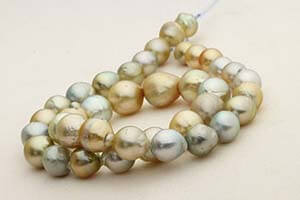
Like Tahitian pearls, South Sea pearls are bead nucleated. But they are the most versatile and expensive among all baroque pearls. Generally, the South Sea Baroque pearls are significant due to big white oysters forming them.
South Sea baroque pearls have a color variation of white to golden, with golden being more expensive. With their sizeable uneven size, South Sea Baroque Pearls’ choker necklaces, cuffs, and bangles are less formal yet elegant, making a statement about themselves.
Akoya Baroque Pearls
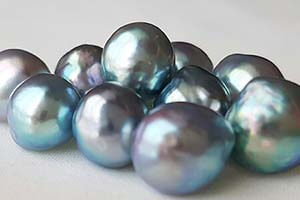
Akoya pearls are classic round pearls that you’ll most commonly see, but they can also be baroque. They are formed in the Akoya oyster. Akoya pearls are sparkling and loved for their lustrous appearance.
Akoya Baroque Pearls typically have neutral colors with overtones of rose and silver. Their price can vary depending on the baroque shape they have. Still, they are less expensive than South Sea and Tahitian Baroque Pearls.
3. Shapes of Baroque Pearls
As beautifully irregular a baroque pearl can be, they are further classified under various shapes. Different shapes make baroque pearls versatile and suitable for different occasions. The price could also be different depending on the shape.
Here are some of the popular baroque pearls shapes:
- Baroques
- Keshi Pearls
- Coin Pearls
- Potato Pearls
- BIWA pearls
- Teardrop pearls
- Twin Pearls
- Cross Pearls
- Rice Pearls
- Egg Pearls
- Leaf Pearls
Baroques: Along with being an umbrella term for irregular pearls, it also covers a popular shape of the pearls. These are long, spherical and have bumps and ridges.
You can consider it a standard shape when you hear the word ‘irregular.’ Baroque is the go-to for less formal styles and is comparatively affordable.
Keshi Pearls: As mentioned earlier, Keshi pearls are a sub-type of freshwater pearls. Their mode of formation makes them distinctive and rare. As freshwater pearls, they can adapt to any shape but are usually long, thin and cylindrical.
Being completely nacre, jewelers appreciate them as the rarest baroque pearls in the market. Their price is also comparatively on the higher end of the spectrum.
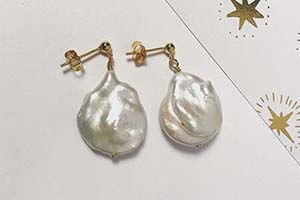
Coin Pearls: As you can judge from the name, these pearls are flat with a large surface area and are quite thin. Due to their large exposed area and patterned appearance, they pertinently reflect light and are very lustrous.
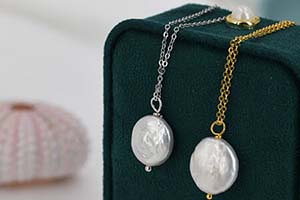
As statement-makers, they are among commonly used yet valuable baroque pearls. They are versatile as pieces of jewelry are made from them.
Potato Pearls: Although not a very refined term for jewelry, potato pearls resemble potatoes. These are compressed, round, long and oblong. Their size differentiates them from other pearls.
Luster, versatility and price all fall in the average category, but color separates from others. Due to their round and ovoid appearance, these make great necklaces.
BIWA pearls: These are long, cylindrical and thin. They are popularly known as stick pearls. Due to their thin and elongated appearance reflect light at a particular angle and hence have a unique luster.
Stick pearls make great earrings and can be worn on formal occasions owing to their uniqueness.
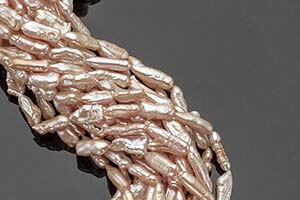
Teardrop pearls: Teardrop is a quite popular shape of baroque pearls and close to the heart of many celebrities. Due to resemblance with a tear, these pearls are minimalistic and jewelry of choice for formal occasions.
Teardrops are no match in elegance, and their rugged surface makes them even more classic. With a diverse range of sizes, the price can also vary.
Twin Pearls: These are timeless and classic yet completely satisfy the definition of baroque pearls. In twin pearls, two types of pearls are fused, with one usually bigger than the other.
These are suitable for bold women who are impact makers due to their distinctive and elegant shape. Twin pearls make great stud earrings and necklaces.
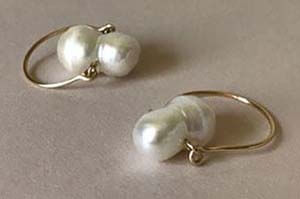
Cross Pearls: These are among the rarest baroque pearls. This shape results from nacre deposition to form a cross-section. Under religious implications, they are used to make necklaces, earrings and pendants.

Rice Pearls: Affordable and tiny, rice pearls can sometimes be quite smooth and round. Rice pearl bracelets and necklaces have the finest elegance in them.
Egg Pearls: These pearls have a wide base and narrow top, resembling an egg. Commonly used in earrings, such shape is not often seen and has comparatively less price.
Leaf Pearls: These have an extremely thin, broad and delicate shape. Uneven and broad surfaces make them glossy. But again, like the egg-shaped baroque pearls, these are less commonly worn pearls shapes.
4. Colors of Baroque Pearls
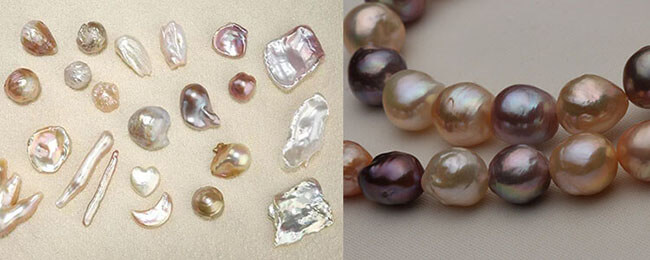
As the diversity in shapes, the baroque pearl color range is also distinct. The standard natural color for many baroque pearls is glossy white. However, dark color Tahitian pearls are equally prevalent. Generally, white, silver, golden, salmon, dark green and charcoal are the available colors.
Things become interesting due to the overtones. Due to the uneven light reflection, different colors could be depicted on a pearl. Cream, purple, rose, and champagne is the most common overtones.
Along with being a crucial factor in the choice of pearl, color also determines the value of a pearl. Dark color baroque pearls are rare and, therefore, high-priced. Similarly, pearls with a golden color and some contrasting overtones have a higher price.
The color of the pearl also somehow impacts the versatility. Glossy white colors are generally more versatile. But the versatility could vary on the type of jewelry and how you carry it.
5. Five Factors That Determine The Value of A Baroque Pearl
Baroque Pearls could be quite valuable depending on several factors. These factors include:
Type of Pearl
The type of pearl is the foremost criterion for judging the value of any pearl. Despite a completely organic growth, Freshwater pearls are less generally considered less valuable than saltwater pearls.
Among the saltwater pearls, South Sea Baroque pearls possess a higher value than the Tahitian pearls.
But alone, the type of pearl is unable to judge the true value of a pearl. Things like luster, color/overtones, shape and most importantly, size can significantly impact the price of the pearl. We’ll be considering these things in the next sections.
Size
The type of pearl is the foremost criterion for judging the value of any pearl. Despite a completely organic growth, Freshwater pearls are less generally considered less valuable than saltwater pearls.
Among the saltwater pearls, South Sea Baroque pearls possess a higher value than the Tahitian pearls.
But alone, the type of pearl is unable to judge the true value of a pearl. Things like luster, color/overtones, shape and most importantly, size can significantly impact the price of the pearl. We’ll be considering these things in the next sections.
Shape and color
The type of pearl is the foremost criterion for judging the value of any pearl. Despite a completely organic growth, Freshwater pearls are less generally considered less valuable than saltwater pearls.
Among the saltwater pearls, South Sea Baroque pearls possess a higher value than the Tahitian pearls.
But alone, the type of pearl is unable to judge the true value of a pearl. Things like luster, color/overtones, shape and most importantly, size can significantly impact the price of the pearl. We’ll be considering these things in the next sections.
Luster
The type of pearl is the foremost criterion for judging the value of any pearl. Despite a completely organic growth, Freshwater pearls are less generally considered less valuable than saltwater pearls.
Among the saltwater pearls, South Sea Baroque pearls possess a higher value than the Tahitian pearls.
But alone, the type of pearl is unable to judge the true value of a pearl. Things like luster, color/overtones, shape and most importantly, size can significantly impact the price of the pearl. We’ll be considering these things in the next sections.
Jewelry Design
The type of pearl is the foremost criterion for judging the value of any pearl. Despite a completely organic growth, Freshwater pearls are less generally considered less valuable than saltwater pearls.
Among the saltwater pearls, South Sea Baroque pearls possess a higher value than the Tahitian pearls.
But alone, the type of pearl is unable to judge the true value of a pearl. Things like luster, color/overtones, shape and most importantly, size can significantly impact the price of the pearl. We’ll be considering these things in the next sections.
6. Usage of Baroque Pearls For Jewelry Making
Baroque pearls Jewelry is a blend of classic heritage and modern minimalism. Some of the popular and worth-considering Baroque Pearl Jewelry items are:
Baroque Pearl Strands and Necklaces
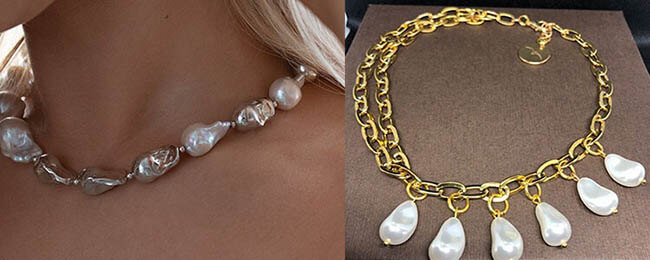
For necklaces, neutral and dark colors, due to their luster, are the choice of most women. Golden with blue overtones is also the choice of many.
The price of strands and necklaces can depend on various factors and vary from $300 to $10,000. However, an average price of $3,000 is where most women get a good quality necklace.
Baroque Pearl Pendants
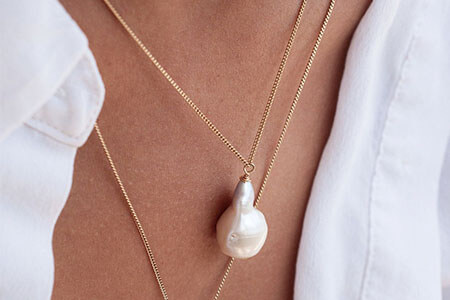
Pedants are for those elegant women who want to keep their look minimal. Due to their many shapes, baroque pearls escalate the sophistication of pendants. Baroque-shaped and coin pearl pendants are quite popular.
For most pendants, white baroque pearls are the top choice, often matched with gold. However, some stainless steel pendants with gold-colored pearls are also quite attractive. Compared to a necklace, Pendants are comparatively affordable.
Baroque Pearl Earrings

Baroque pearls are most often paired with earrings. Due to their long design, the earrings are eye-catching even at first glance. From casual to formal occasions, the baroque pearl earrings are suitable for any occasion.
The earring size could vary according to the face, and the choice of pearl could be according to the occasion. Many women love to combine a gold pendant with glowing white baroque pearl earrings.
Baroque Pearl Rings
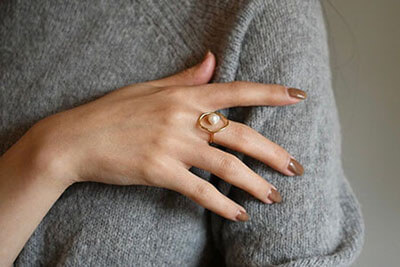
Rings having baroque pearls are not seen very often and are for special occasions. A complete exposure is not suitable in a ring for protecting the pearl. Thus halo or bar setting is often recommended.
Final Thoughts
If you’ve learnt a lot about baroque pearls from this article, share it with your friends or on Facebook, Reddit, Twitter, Quora, etc.
We’re Jingsourcing, a leading sourcing company in China. We can help you wholesale and customize fashion jewelry designed with baroque pearls. If you need help, feel free to CONTACT US.

Fascinating read! I had no idea there were so many factors that affected the value of Baroque pearls. Learning about their unique characteristics and the way they’re evaluated has given me a new appreciation for these beautiful gems. Thanks for sharing this informative post!
Interesting read! I had no idea there were so many factors that can impact the value of a Baroque pearl. Thank you for sharing this informative post.
I love learning about different types of pearls and this post was very informative. I especially liked the information about baroque pearls and how to determine their value.